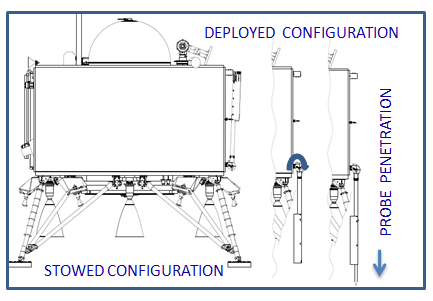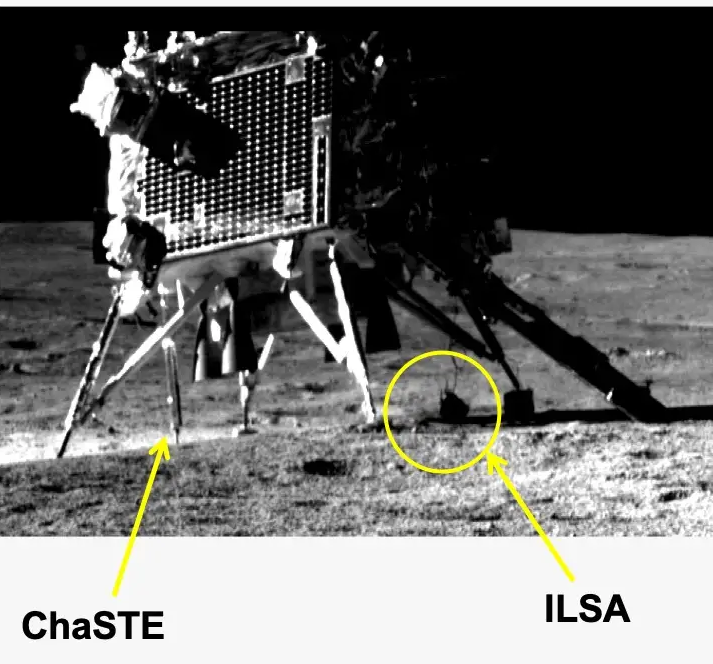ChaSTE payload aboard Chandrayaan-3
The information on temperature and thermal conductivity of lunar surface regolith are critical parameters that decide the depth of solar forcing and the loss rate of volatile, including the water ice in the polar and near-polar regions, particularly in the sun-illuminated regions.
Lunar temperatures at the sub-solar point approach ∼ 400 K, whereas temperatures in regions of permanent shadow may be lower than 40 K. Most of the in-situ probing conducted by Apollo missions are in and around the lunar equatorial regions. These missions provided detailed information on the vertical variation of geophysical parameters such as bulk/packing density of regolith, thermal conductivity, temperature variation and many other thermo-physical parameters and the chemical composition. Thermal and electrical properties of the near equator region of the Moon had been investigated based on the in situ measurements during the Apollo and Luna missions. The thermal behaviour of Lunar regolith within the top 20-30 mm is suggested to be significantly different than that at greater depths and expecting drastic change in temperature in the top few centimeters of the surface. Precise information about the exchange of heat within these layers is required for obtaining an understanding on balance between the external (solar) and internal (due to radioactive decay) heat fluxes for estimating the thermal state of the Moon. Orbiter-based remote sensing provided the global map of the thermal properties of the Lunar surface and subsurface properties of regolith, the thickness of regolith layers, mineral content, and the electric and magnetic properties of the lunar surface. The permanently shadowed regions in the poles are mapped, thereby proposed the possible presence of water ice deposits. The recent confirmation of the water ice presence in the polar region is directing more and more investigators towards the Lunar poles.
However, the in situ measurements of lunar thermo-physical properties of surface/subsurface regolith in the near-polar/polar regions are yet to be achieved.
The very low thermal conductivity (<0.03Wm−1 K−1), wide range of day & night temperatures, large variation of regolith density with depth, and the tenuous exosphere make the in situ probing of lunar surface a challenging task.
> Chandra's Surface Thermo-Physical Experiment (ChaSTE) is one of the payloads aboard the Lander of the Chandrayaan-3 mission developed by Space Physics Laboratory, VSSC in collaboration with Physical Research Laboratory, Ahmedabad, with the aim to study the thermo-physical properties of lunar regolith in the near polar region by in-situ measurement of vertical temperature from surface to 100 mm depth.
>ChaSTE measures the vertical temperature gradient and thermal conductivity within the top 100mm at the Chandrayaan-3 landing site.
>The objectives of the ChaSTE payload are accomplished by inserting a probe which houses 10 Resistance Temperature Devices (RTD) made of Platinum (Pt-1000) located at different distances along the axial direction and a heater bounded around the probe near the tip.
The major objectives of the experiment are:
1.Vertical thermal gradient measurements
This experiment is a passive mode operation in which thermal sensors mounted at different depths on the probe are continuously activated for sensing the temperature at the interval of a second and obtaining the the temperature profile of the top 100mm.
2.Thermal Conductivity (λ) measurements
In this experiment, the regolith medium is heated by giving a known amount of current to the heater, which is circumscribed on the cylindrical thermal probe. The temperature variation of the heater with time is monitored continuously during the experiment by using a thermal sensor that is in contact with the heater. As the heat conduction of the heater is related to the thermal conductivity of the medium in which the heater is in contact, the thermal conductivity of the regolith can be estimated by measuring the time variation of the temperature of the heater.
This experiment is an active mode operation. In order to meet the science objectives, ChaSTE payload has the following major modules.
Thermal Probe
A probe, that has 10 thermal sensors to reconstruct the temperature profile of regolith medium from the point measurements and a heater to study the thermal conductivity, which can also undergo wide range of temperature variation. In order to achieve the low thermal conductivity and sufficient mechanical strength for the ChaSTE probe, probe material chosen is a syntactic foam composite consisting of a blend of cyanate ester and urethane modified epoxy as polymer matrix. The matrix is further reinforced with glass fiber, glass micro balloons and cork. The composite is processed by compression moulding technique and finally machined into the required dimension.
Thermal sensors and heater: Platinum resistance thermometers (RTD, Pt-1000) are selected as the temperature sensor for this experiment after critically evaluating the temperature range and different methods of temperature measurements. The Pt-1000 temperature sensors were found to be the most suitable for this experiment because of its high linearity for the measurement temperature range and accuracy.
Measurement of thermal conductivity is done by heating the regolith by powering a heater and measuring the subsequent change in the heater temperature with progressing of time. Heater used for the thermal conductivity experiment is custom made capton foil type heater which suites the probe.
Deployment and penetration mechanism: In order to keep the thermal probe stowed to the +Y panel of the Lander during the flight, to deploy it after landing and to insert the probe into the regolith to measure temperatures up to a depth of 100 mm, motor driven deployment and penetration mechanisms are developed. The mechanism is able to withstand the loads during the probe penetration. Penetration operation is done sufficiently slow so as to cause minimum disturbance to the regolith. The clearance between the lander bottom deck and the surface may vary depending upon the articulation of the landing gear upon touchdown. The mechanism provide ∽100 mm tolerance under the above circumstances. Heat transfer between the lander panel to temperature sensors through the mechanism elements is minimized. The mechanism is designed to withstand the quasi static and dynamic loads during all flight regimes including landing. The system should also withstand thermal and radiation environment during all phases from launch till landing.
Natural frequency of the system in stowed condition is >120 Hz. Total mass of the system including the probe and its harness is 2.5 kg. The maximum power allotted for the system is limited to 35 W. The payload has three-point fixity on the Lander +Y panel with a passive support at the centre. At the top (fore-end) the payload is held by a Hold & Release mechanism, which will release it on command for deployment. The payload is hinged at the bottom end (aft-end) where the deployment mechanism is housed. The deployment mechanism rotates the probe from the stowed position and locks it to a configuration normal to the lander bottom deck. The thermal probe is housed towards the fore-end of the payload housing where the penetration mechanism is housed. The probe shall be inserted slowly into the lunar regolith up to the required depth of ∼140 mm. The Hold & Release mechanism uses a Frangi-bolt assembly which holds the payload in the stowed configuration during flight and releases it on command after landing. The Frangibolt assembly consists of a notched bolt which fastens the rail to the Hold & Release bracket with a specified preload. A Shape Memory Alloy (SMA) actuator is sandwiched between the lock-nut and the Hold and Release bracket. Heating of the actuator electrically causes it to elongate due to phase transformation and resulting in the fracture of the bolt at its notched plane, thereby enabling release of the rail from the housing.

Figure: Functions of deployment and penetration mechanism of ChaSTE probe.
Onboard electronics module: Functions of Onboard Electronics include power ON and OFF the payload, excitation of RTD sensors, acquisition of analog voltages of the RTDs, motor current and probe heater current, digitization of the analog voltages, driving motors associated with the deployment and probe insertion into lunar regolith, data transfer to Lander, driving probe heater for thermal conductivity estimation (active mode operation), reception and execution of tele-commands for motor and heater drive operations and generation of telemetry for motor drive and probe insertion status.
The onboard electronics is a micro-controller based system consisting of two cards-the front-end electronics card and the processing electronics card. The onboard software of ChaSTE is designed and developed in assembly language for 80C32 micro controller by using KEIL IDE. The electronic cards and the DC-DC converter are housed in a single chassis. The DC-DC converter and other heat dissipating components are housed in the bottom of the chassis in direct contact with the chassis to facilitate the heat dissipation. Thermal analysis has been conducted for the conditions such as radiative interaction within the electronics box and radiative interaction of the electronics to outer with inside ambient.
Performance of ChaSTE payload in Chandrayaan-3 mission

ChaSTE, was released from its stowed configuration at 02.00 hrs on 24th August, by actuating the Shape Memory Alloy (SMA) actuator, thereby fracturing the Frangi-bolt. Release time and current was nominal. Subsequently the deployment motor was powered and the instrument was deployed and locked to point towards the lunar surface. The deployment motor current was nominal. The thermal probe was driven in steps by powering the penetration motor. Temperature data from the probe sensors was analyzed to confirm that the sensors have touched the regolith. The probe was inserted 140mm inside the lunar regolith. The penetration motor current was nominal.
All activities were conducted by the tele-command through ChaSTE electronics and telemetry were received all though the experiment. The BDH data were dumped in regular intervals.
All operations on ChaSTE have been conducted successfully and the performance was nominal.